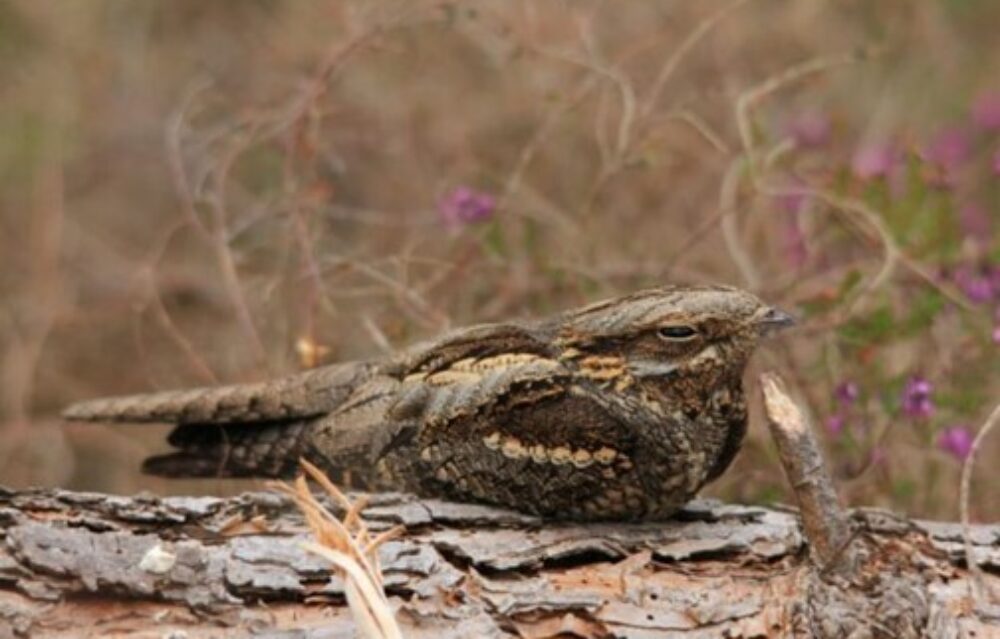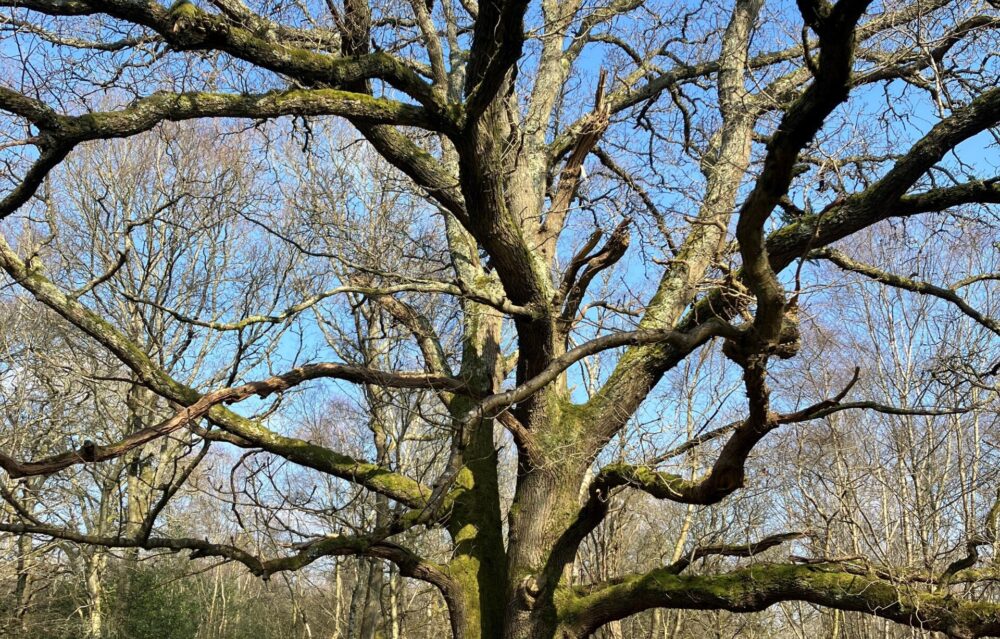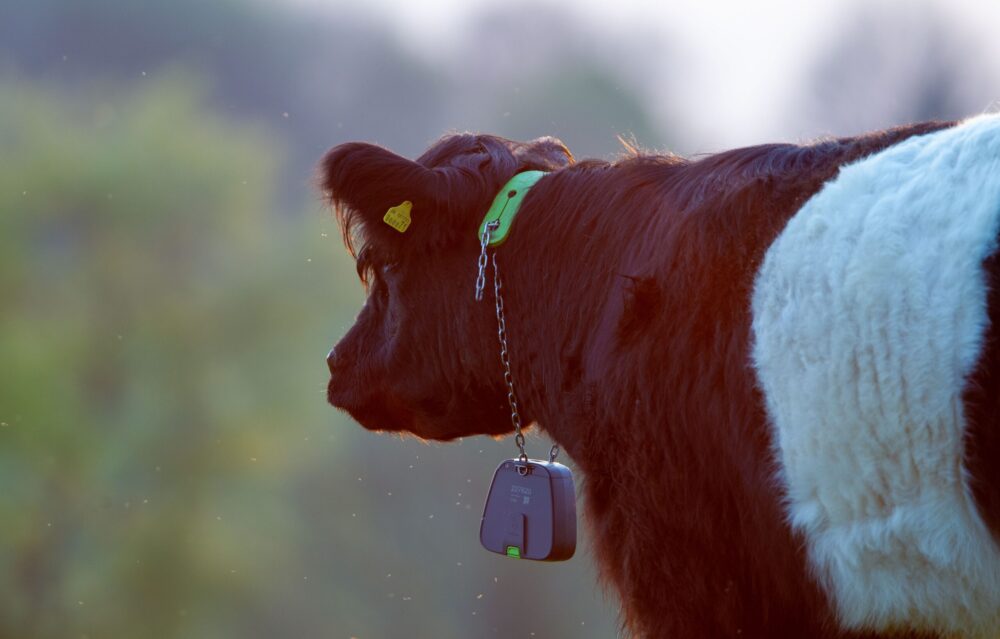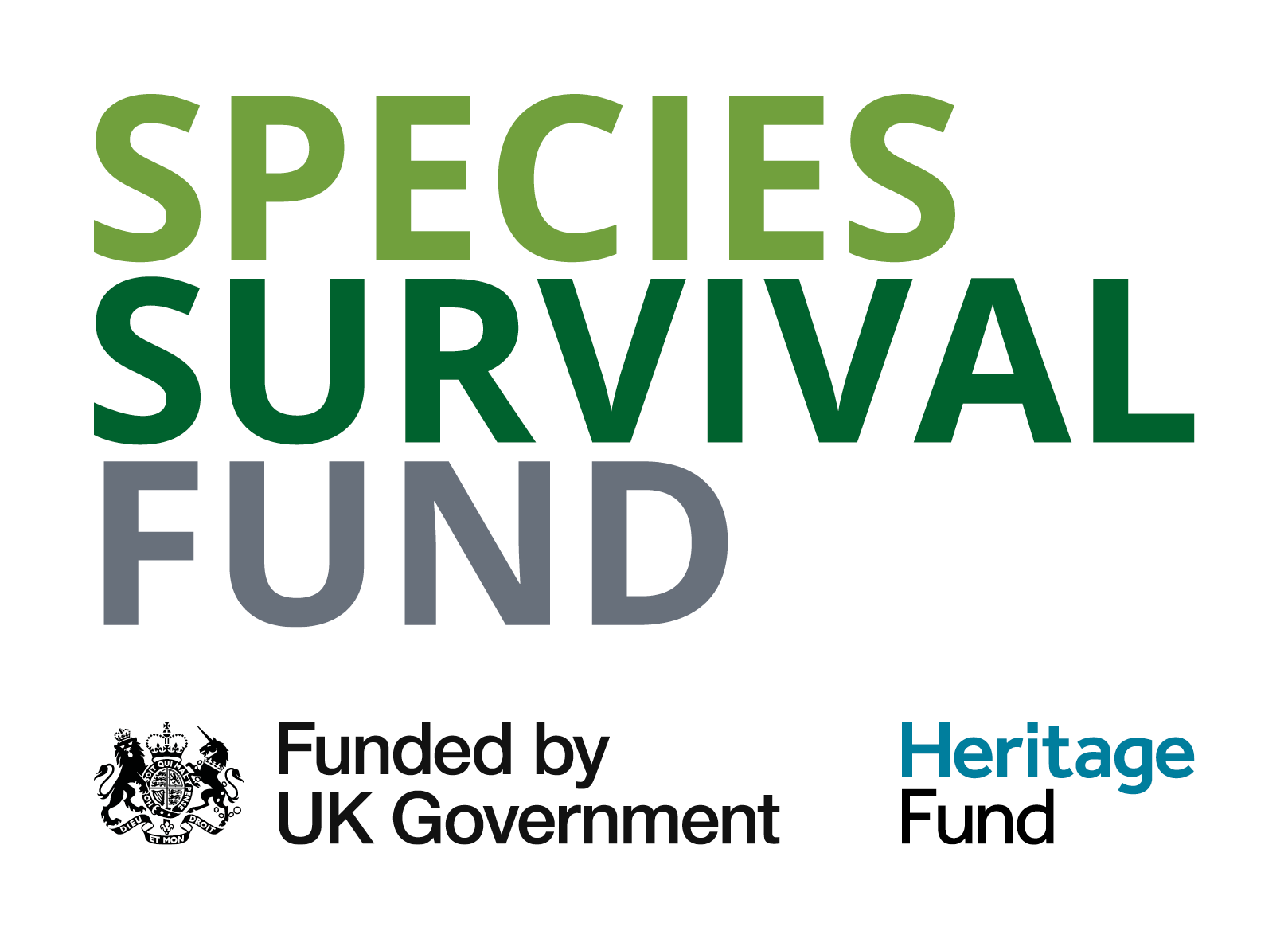On a recent visit we saw some fantastic progress on habitat restoration on Bucklebury Common, to protect rare heathland and wood pasture species.
The Common is one of seven sites in our Partnerships for Nature (P4N) programme – which is funded through DEFRA’s Species Survival Fund (SSF) administered by the National Lottery Heritage Fund. The Bucklebury Common project covers 266 hectares of wood pasture, restored heathland and newly created heathland, and is expected to lead to a significant increase in a wide range of species, including heathland birds, reptiles, bats, and butterflies.
The work is being led by an expert team. Estate Manager Alasdair Jones-Perrott has over 25 years’ experience in conservation management, and Consultant Ecologist Alex Cruickshank has over 25 years’ experience working in nature conservation, including numerous heathland restoration projects.

Heathland restoration
Heathland is an important habitat for the survival of some rare species, including woodlarks, adders and the Dartford warbler, but there is very little heathland remaining in the North Wessex Downs. Bucklebury Common is the largest remaining area of lowland heath in the North Wessex Downs – and this project will more than double its size to 66 hectares.
The heath would originally have been grazed by wild herbivores and was then grazed by cattle. But since cattle grazing stopped after the Second World War the heath has become overgrown with invasive birch. An area of birch has been cut back, allowing heather seeds that have lain dormant for over 80 years to germinate. Though these areas may look muddy now, with time they will regenerate, offering essential refuge for a wide range of wildlife.
Nightjars are one of many rare species to benefit from this project
These migratory birds, arrive from sub-Saharan Africa in spring and require open, heathy areas to nest on the ground. The easiest way to find out if the nocturnal and well-camouflaged nightjar is about is to listen out for its distinctive ‘churring’ call at dusk. Learn more about Nightjars here.
Image: Nightjar roosting. Credit Rob Solomon

Protection of 200 veteran trees
The project includes wood pasture restoration which will protect around 200 Veteran trees. Alex Cruickshank from Sundew Ecology explains their importance:
“Old trees are a valuable resource for wildlife and an important part of Bucklebury Common’s history. Many of the older trees on Bucklebury Common are overcrowded by lots of younger, taller trees. This reduces their lifespan and their ability to support an abundance of wildlife.”
With the help of volunteers from the West Berkshire Countryside Society, veteran trees are being ‘haloed’, by removing younger trees around them. Alex explains that this will increase the longevity of the veteran trees, “allowing them to form lots of features which are great for wildlife like cracks and hollows, dead branches and ‘epiphytes’ – other plants growing on the tree.”
Wood pasture is also being restored by pollarding of younger trees – trees are cut above the reach of livestock and deer, and they resprout with lots of fresh growth. This increases their longevity and provides useful resources for people and wildlife.

New homes created for adders
Bucklebury Common is home to a small but very important population of adders, an increasingly rare reptile. The adder is the UK’s only venomous snake, but its venom is generally of little danger to humans. Adders hibernate during the winter in structures called hibernacula. These are often natural, formed of narrow cracks in the roots of old trees, or rodent burrows. To increase the population of adders, artificial hibernacula are being build using logs and soil. These will provide additional spaces for them to hibernate safely through the winter.
Reintroduction of cattle grazing
Cattle grazing will return to the common to help maintain the heathland and wood pasture and prevent invasive birch trees regrowing. Another benefit of cattle grazing comes from cattle dung – which provides a fabulous resource for insects and fungi.
A small herd of Belted Galloway cows will be introduced in the autumn – with the help of invisible fencing. GPS collars are used to alert cows when they reach a boundary, and grazing boundaries can be defined via a simple phone app – making it much easier to manage than using physical fences. Learn more about the use of this technology in the North Wessex Downs here.
Image: Belted Galloway with a NoFence collar. Credit: Charles Sainsbury-Plaice
Frequently Asked Questions
What has been done to involve local people in the work being carried out?
From the early planning stages of the project, the public has been invited to learn more about the proposed plans by attending one of the 17 information sessions. These have ranged from formal sessions at the local village hall to informal walks to observe and understand the work on the common.
An additional two walks are planned for June 2025 (5th & 13th June) to show visitors the work that has been carried out and to learn more about the process from the Bucklebury Estate team.
Who is responsible for the work being carried out on Bucklebury Common?
The work is being led by an expert team at Bucklebury Estate, including Estate Manager Alasdair Jones-Perrott who has over 25 years’ experience in conservation management. The work is supported by consultant ecologist Alex Cruickshank from Sundew Ecology who also has over 25 years’ experience working in nature conservation, including numerous heathland restoration projects.
Who is paying for the work?
The work to restore wood pasture and enhance the existing heathland is part of the North Wessex Downs National Landscape Partnerships for Nature programme, which is funded by Defra’s Species Survival Fund. The Estate is also privately funding some of the work and additional funding has been provided by Defra’s Access for All funds and Farming in Protected Landscapes funds.
Bucklebury Common also receives government funding through a Countryside Stewardship agreement which runs for ten years. This funding covers some of the large-scale habitat work to restore the heathland and create new gullies.
Why is the existing habitat being disrupted when it is already rich in wildlife?
To restore the heathland areas on site, dense birch scrub has been removed to allow the heathland to recover. Heathlands are internationally rare habitats which are severely under threat from changes in land use and lack of management. As a result, the species which have evolved to live on heathlands are under threat. We are looking to encourage a greater diversity of heathland species such as nightjar, Dartford warbler, woodlark, silver-studded blue butterfly and adder as well as a wide range of lichens, mosses and fungi.
By creating open areas within the woodlands, we are allowing light and air to reach the woodland floor which will encourage the flora to flourish. This is turn will have a greater benefit in supporting more species of invertebrates such as butterflies and moths, birds and bats.
What steps have been taken to ensure the work doesn’t harm existing habitats?
There are lots of elements to the project, but the majority of it is heathland restoration in which a monoculture of young birch is removed to expose the bare gravel on which the heathland flora will re-grow. In these areas, we want to disrupt the soils to expose the mineral layer and the potential heathland seedbank. In other areas, which are identified as future wood pasture, we are using less disruptive methods. Walkover ecological surveys were undertaken in all areas to identify sensitive features, and these were avoided when planning the work.
The majority of the work carried out on site has to take place outside of bird nesting season (March to September) to limit disturbing not only birds, but also reptiles, invertebrates and mammals which are more active during this time.
Why has the work been carried out so quickly?
Nature conservation projects like this are often governed by the grant funding available. The Species Survival Fund requires capital works to be completed by the end of 2025. We are ensuring the work leads to the best possible outcomes for wildlife in the long term within these timing limitations.
Equally, the Countryside Stewardship Scheme expects its funded capital works to be completed within the first two years of the scheme, which when balanced with working outside nesting season, gives a short window to complete the work. However, the short-term impacts of carrying out the work will be greatly outweighed by the long-term benefits to the threatened heathland habitat and the rare species that depend on it.
How have you ensured that the soil is not damaged by the use of heavy machinery?
For heathland restoration to be a success, the site needs free-draining, nutrient poor soils. In these areas, the soil that has built up because of years of neglect will have detrimental impacts on the heathland, therefore it’s essential that we remove as much of the soil as possible.
In other areas on the common, heavy machinery has been restricted to set routes to limit compaction across the habitat. The ruts left behind will be raked over and broken down, these areas will become more permeable with better drainage and aeration which will lead to a healthy plant community.
The heavy machinery used on the common have all had tracks which reduces ground pressure to minimise soil compaction and damage. In particularly wet areas, brash mats (created using the branches of trees) were used to bring an additional level of protection.
Why are you cutting down trees which store CO2?
Bucklebury Common is fortunate to be home to one of the largest areas of lowland heath in the south of England. The extent of heathland has decreased by 85% since WWII, primarily due to the drastic changes in land use. Heathlands are a rare habitat which support a wide range of endemic species which cannot be found elsewhere. Heathlands are also vital as carbon sinks because, like trees, they can absorb and store vast quantities of CO2 from the atmosphere. The restoration of heathland has been shown to emit small amounts of carbon, however as the heathland recovers, then the process of carbon capture begins. There is a growing need to restore unique habitats such as heathland, not only for their ecological importance but for their future role in carbon capture.
Is the wood cut down being sold to make a profit?
No, the primary aim has been to remove low quality trees to create high quality habitats. All the wood has been utilised which has meant that nothing has gone to waste. Material has been sold as biomass, firewood or to produce fence posts. The return on the timber sales is either less or equal to the cost to fell and process it.
How will cattle on the common be managed?
A herd of ten young Belted Galloway heifers will be added to Bucklebury Common during September 2025. The cattle will be trained on NoFence, a GPS tracking system which has been extensively used on similar sites across the UK and Europe.
The cattle will each wear a collar around their neck when they are on site, these can be updated on an app to allow the Estate to create a virtual fence for the cattle. The cattle will be trained to respond to the audio cues when they are approaching the boundary edge. If they continue, then they will receive a small electric shock which will encourage them to turn around and return to the grazing area.
The herd will spend time in a training area off the common to learn the system and how it works, they will only be put out onto the common once we are confident they have fully learnt the system.
Visitors to the site will be able to scan a QR code at the main entrance points which will allow them to see a live map of where the cattle are, giving the public the freedom to either avoid the cattle or to find them.
Daily livestock checks will be carried out by the Bucklebury Estate ranger and a small group of trained volunteers.
What is being done to improve accessibility to the common as part of this project?
The public rights of way will be restored to their previous state as the weather allows and newly surfaced footpaths will also be added. The new trails allow visitors to carry out a circular walk on site and have been designed to be accessible to a wide range of visitors. The two main car parks along Broad Lane have been resurfaced and extended to allow more cars to park safely.
There are six new interpretation boards which have been installed across the common to provide information to visitors. These also include a map of the site with key features highlighted.
How will the restored habitat be maintained in the years to come?
A key element to large scale habitat restoration works is the management in subsequent years. Bucklebury Estate is fully committed to continuing to restore and enhance the habitats. With the capital works completed, any future work will be at a considerably smaller scale which will predominantly be undertaken by hand with small machines used where required.
The introduction of the cattle will help contribute to ensuring recently cleared habitats are kept clear from species encroachment. The temporary ranger position funded by The Species Survival Fund will be made permanent by Bucklebury Estate.
Get Involved and Find Out More
If you’d like to get involved in this project you can join the Friends of Bucklebury Common volunteer group. There will be something for everyone, including helping to educate people about the common, site monitoring and practical habitat restoration tasks. Contact Sam, the Bucklebury Estate Ranger to find out more.
Find out more about the work at Bucklebury Common in this report by Sundew Ecology (Note: not all of the work covered in this report is part of the P4N project.)
Or email Alasdair Jones-Perrott, Estate Manager
Find out more about all of the projects in the Partnerships for Nature Programme here.

The Partnerships for Nature programme is funded by Defra’s Species Survival Fund. The fund was developed by Defra and its Arm’s-Length Bodies. It is being delivered by The National Lottery Heritage Fund in partnership with Natural England and the Environment Agency.

